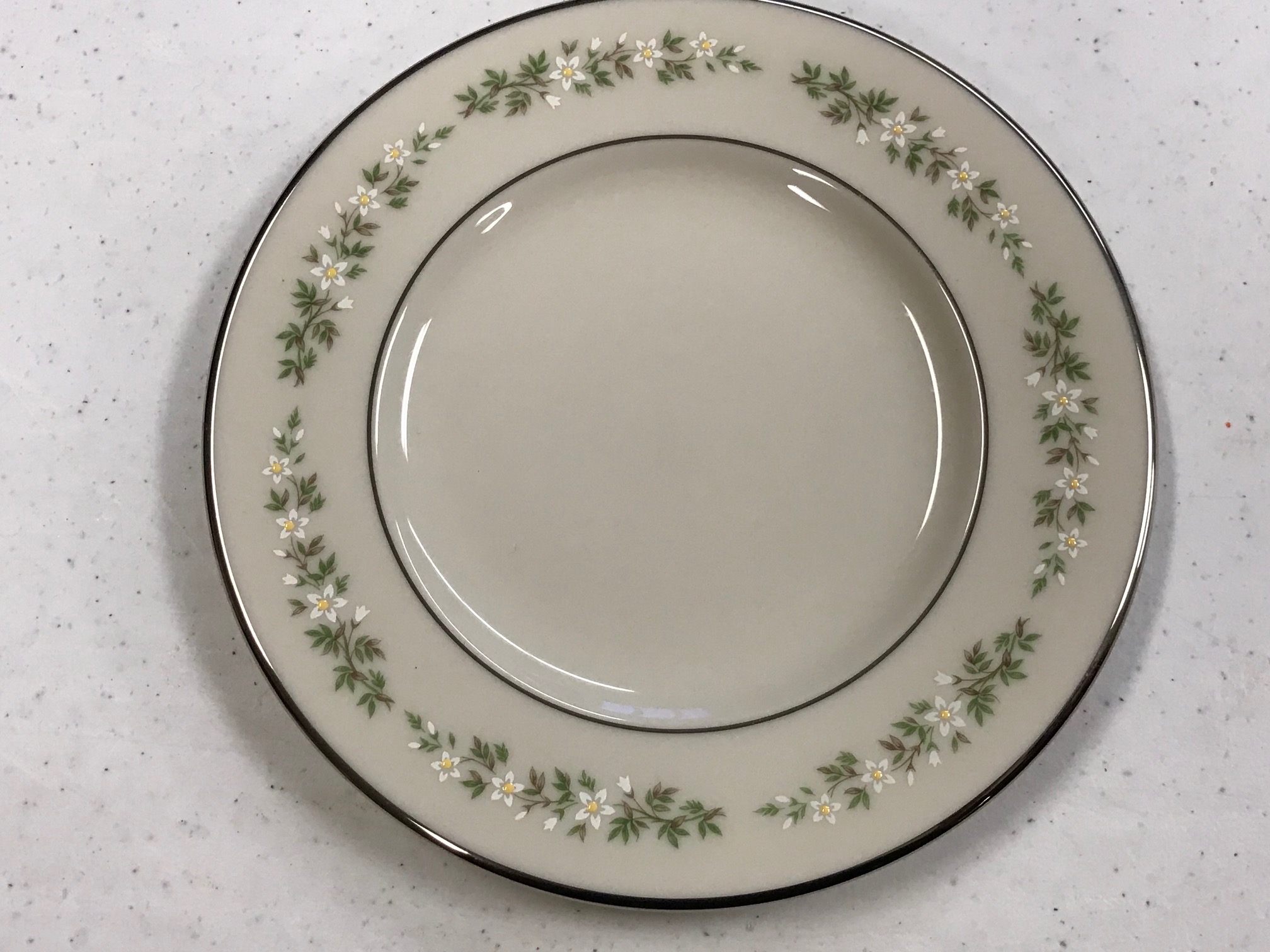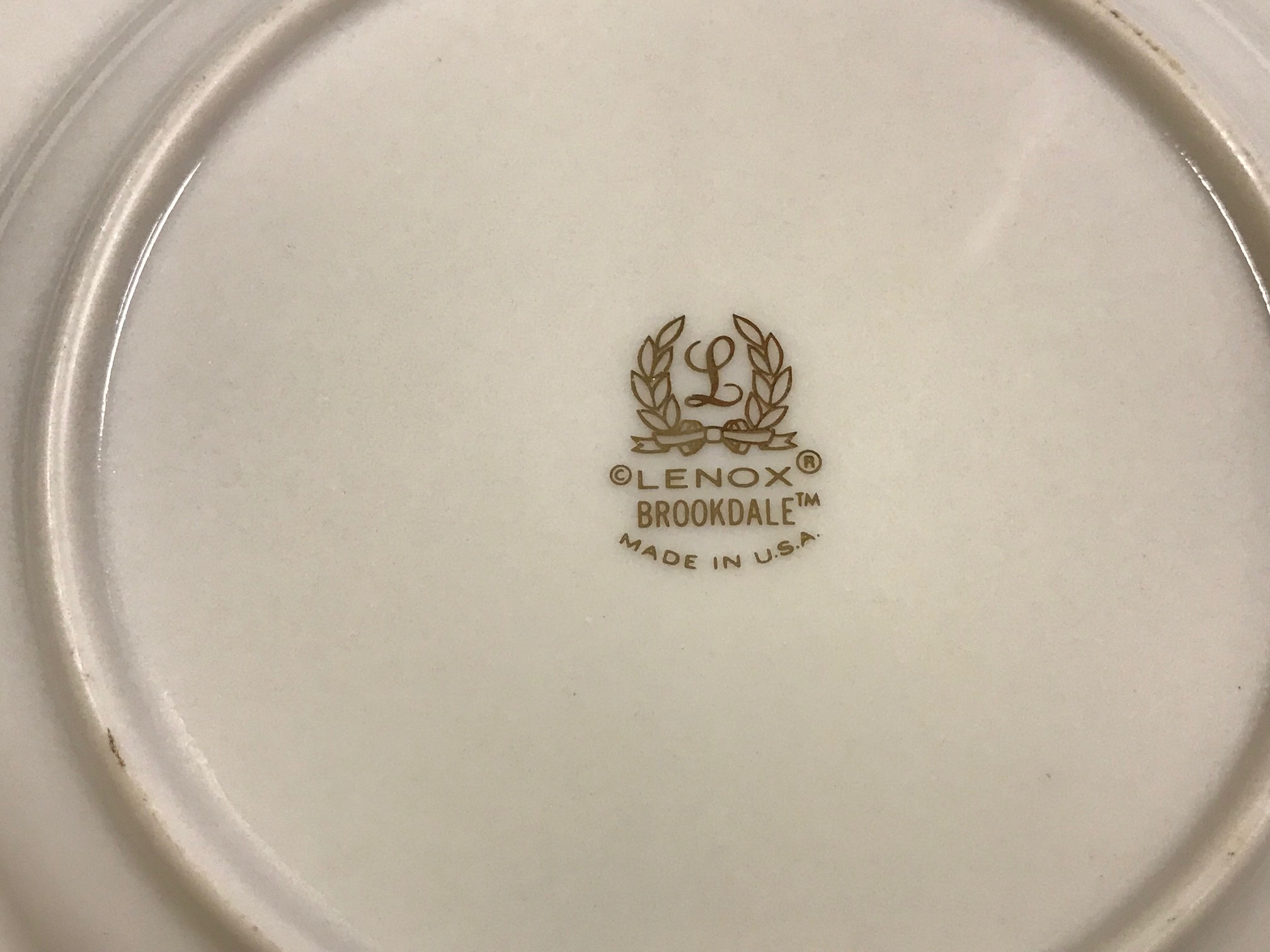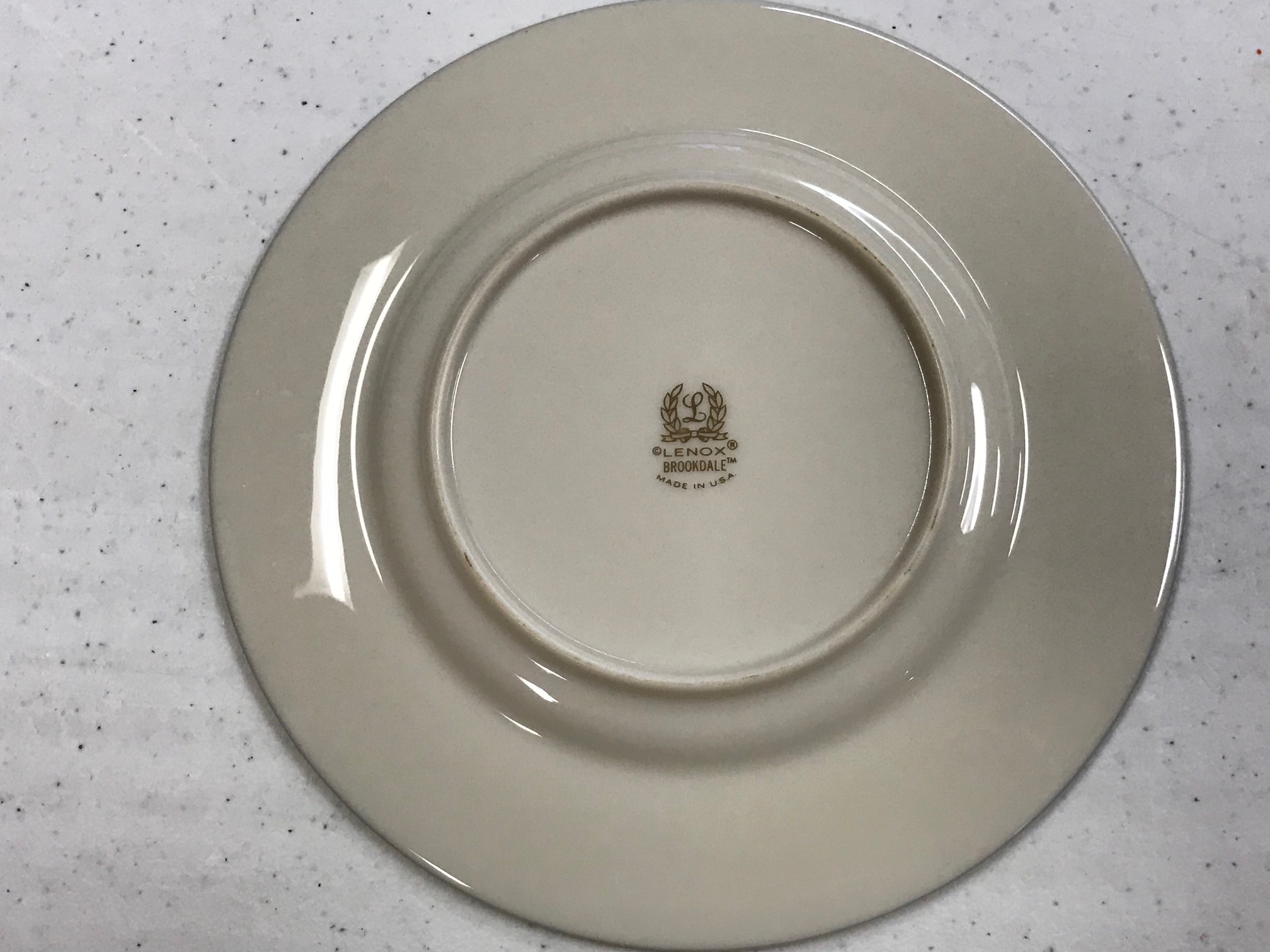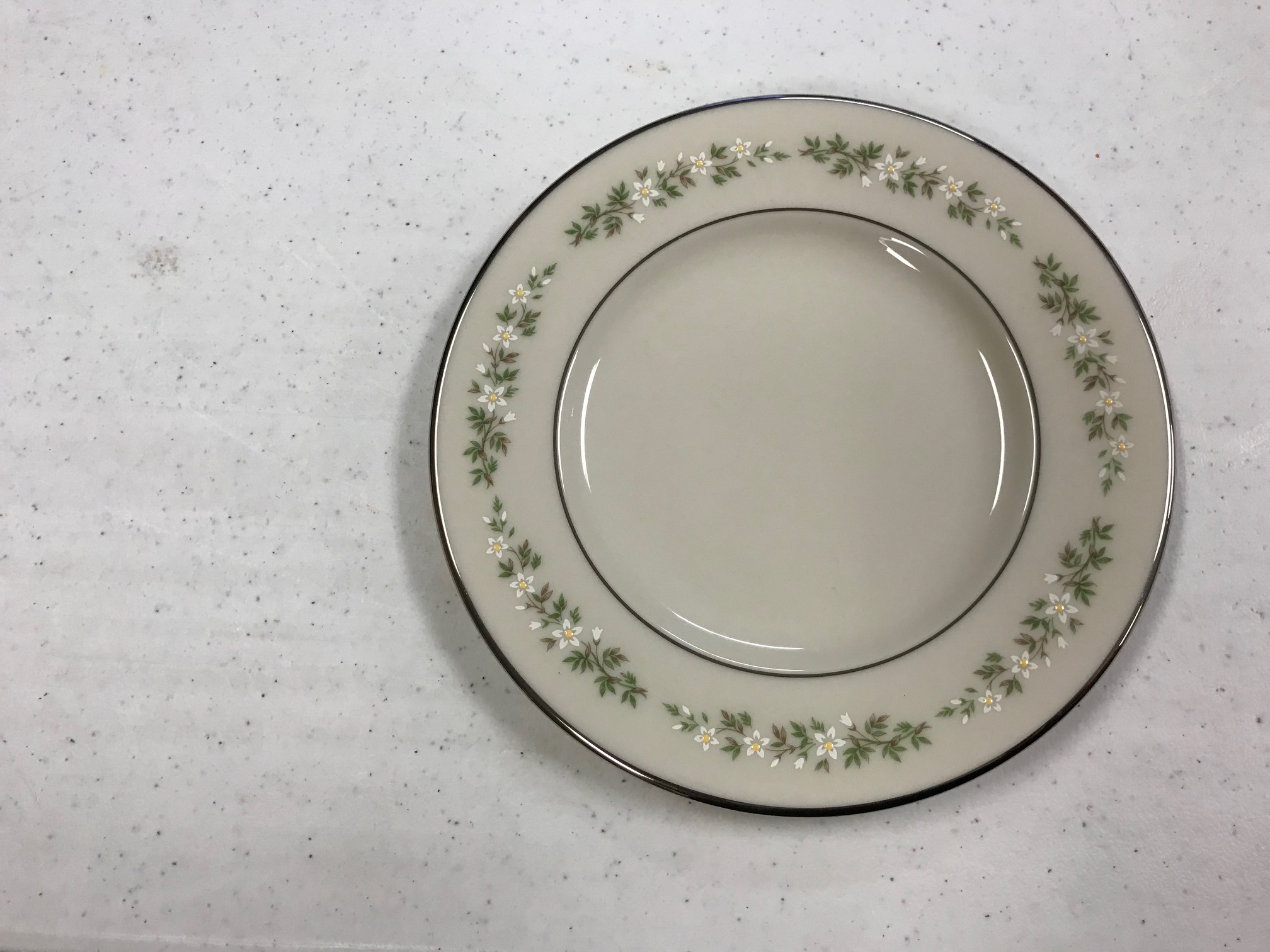This vintage Lenox china has glaze that’s more than 13% Lead! [136,000 ppm] – 90 ppm is unsafe for kids.

Lenox “Brookdale” Pattern, Made In USA china.
This little dish was brought to me at an event in New Hampshire recently. My facebook friend sent her mama to my event and told her to bring a few dishes with her, in case I would be able to test them. She brought these and a couple of others.
She’s a grandma, and I was happy to have tested these for her because the “Grandma Scenario” I usually share with people I have home visits with was very relatable for her.
Here’s the “Grandma Scenario”:
You love your children. You love their children. Your grandchildren love you back and will have fond memories of “Grandma” for the rest of their lives. Grandma’s vintage china has Lead. Grandma doesn’t know this (or learns about it, but doesn’t think it is really a big deal that it has Lead because “she only uses it for special occasions”). Grandma dies. Grandma leaves the fine china to her children and grandkids to remember her by. Grandchild gets ready to go off to college & brings a set of Grandma’s fine china to use as their dishes at college, including a teacup or coffee cup (as a way to “keep Grandma in their life” now that she is gone.) Grandchild uses those as everyday dishes. The dishes are now 50 or 60 or 70 years old. They have been used with all kinds of food – including acidic salad dressing and tomato sauce and coffee and tea – literally for decades. They are now leaching Lead into pretty much any food they are used with.
I don’t say that about all dishes – but this type and age of dish – with this level of Lead. – is very likely to poison someone who uses them on a regular basis (immediately or eventually.) It’s hard to say exactly how toxic they might be — since no one has ever done a comprehensive study of whether or not (or how quickly) vintage dishes may poison the user [there’s no money in doing a study like that & therefore no industry benefits!.]
To learn more about XRF testing, click here.
I knew this would be high Lead, but am frankly always surprised when things come in THIS HIGH. Here are the XRF readings for this particular piece:
- Lead (Pb): 136,000 +/- 5,900 ppm [13.6% Lead]
- Mercury (Hg): non-detect/negative
- Arsenic (As): non-detect/negative
- Cadmium (Cd): non-detect/negative
- Barium (Ba): non-detect/negative
- Chromium (Cr): non-detect/negative
- Antimony (Sb): non-detect/negative
- Selenium (Se): non-detect/negative
To see more Lenox brand pieces I have tested, click here.
For context, the amount of Lead that is considered toxic in an item intended for use by children is anything 90 ppm or higher in the paint/glaze/coating, or anything 100 ppm lead or higher in the substrate. This plate contains 136,000 ppm lead.
Vintage dishware is not regulated for total Lead content [as detectable with an XRF instrument.]
I would definitely rate something like this to be a solid Grade “F”! Vintage dishware like this is not only usually very high in Lead, it also often even tests positive with a LeadCheck® swab, which indicates the glaze is worn and the Lead can likely leach into food – at very high levels.
Please consider reading this linked story about a little boy who was poisoned from using a leaded china bowl for breakfast – a piece similar in age to this one (yet with less than half the amount of Lead!)
Not sure what to do with your leaded vintage dishes? Check out this post linked here for ideas.
As always, please let me know if you have any questions.
Thank you for reading and for sharing my posts.
Tamar Rubin
#LeadSafeMama

Never Miss an Important Article Again!
Join our Email List





Dear Tamara Rubin…….I was very intrigued by your video concerning XRFtesting for Instant Pot. I just purchased the Instant Pot Ultra from Sur La Table. (It has the stainless steel insert pot, but it is 8/10 compared to the higher grade st. st. of 18/10.) I am wondering whether I should return it or just be extra careful using it.
I’ve been using Corelle dishware for my family for many years. (The set is mostly white, except for the large plates and cereal bowls having a blue design on the edge.) I’m really concerned about the cups/mugs because they are stoneware, made in China. I don’t drink from them anymore…but my husband does. He doesn’t believe there could be anything bad in them. I drink from a glass see-through mug…..but wondering if there is lead in those.
Tamara….what do you recommend that people should drink from? Thank you in advance for your answer.
I am so grateful that somehow I’ve come across your website. I’m looking forward to receiving your newsletters.
These are all great questions! I have hands full with kiddos right now (Sunday morning, with a Halloween parade in the neighborhood coming up today), but wanted you to know I got your comment and will answer it a.s.a.p. If you want, please send me a picture of your mugs and your dishes (via e-mail) and I will give you a educated guess that way.
Hi Tamara,
I have been searching for lead free toys and dinnerware and so on for the past 3 years. I can’t believe it has taken me 3 years to find your site!!!
I am wondering if you can check the Lenox Butterfly Meadow Dinnerware collection for lead? Though I do not serve anything to my child with it, I do suspect it probably contains lead as I cannot find information on Lenox or anywhere else about this particular piece!
Could you please test it ?
The way it works is people send me things to test and contribute to help cover the cost of the testing. There is more information about that here: https://tamararubin.com/2017/07/subscribe-in-support-of-my-advocacy-work-you-can-become-eligible-to-send-in-a-box-of-your-things-for-testing/
Hi, Thanks for your article.
I was interested in the origin of the Lenox Brookdale pattern and happened across your article about 136,000 ppm in the glaze.
I contacted Lenox and their reply is that they do not claim to be lead-free, however, they state they are at acceptable safe levels of lead content.
Now, my problem is that I love using the Brookdale set. It looks like I bought it yesterday.
But, you say it has high-levels of lead, Lenox seems to refute it (in so many — few — words).
They would not comment on the article that I included as a matter of company policy.
Thanks,
Bill
Unfortunately their company policy (many of these companies actually) is to deny culpability for historic / legacy products made before current regulatory standards were put in place. Please read this post for more information: https://tamararubin.com/topics/does-vintage-and-new-functional-pottery-and-dishware-have-unsafe-levels-of-lead/
Tamara
i have this china and had it checked.. your findings are incorrect.
Hi Valerie –
Thank you for commenting.
Did you check it with a $50,000 XRF instrument with a consumer goods mode function installed? Or with a home test?
The instrument I use is a scientific tool not readily available to consumers. In fact the instruments are very rare and few home hazard assessors have them as well. Home tests (like the reactive agent LeadCheck swabs) do not usually work on china as they were designed specifically to test for Lead in house paint, not to test for Lead in consumer goods. I have a post about that here: https://tamararubin.com/2017/02/ask-tamara-q-can-i-test-my-dishes-for-lead-with-a-leadcheck-swab-a-sometimes-but-not-always-click-to-read-more/
Additionally all of the test results I share on my blog are accurate, science-based and replicable – to the extent they would even hold up as evidence in a court of law if necessary (for example if bring a manufacturer to task for producing toxic goods.)
Here’s a post about the instrument I use and the testing methodologies I employ: https://tamararubin.com/2016/12/ask-tamara-what-do-you-use-to-test-for-lead/
Tamara
Hi Tamara,
I was looking at purchasing the Lenox Kingsley vintage set and just read some of your articles. The set I’m looking at was not tested and I can’t seem to find anything about it specifically related to lead. Since it was manufactures prior to 1971 is it most likely to have high lead?
Have you tested the Lenox Autumn China pattern for lead content? I have a set from the late 1970s.
Also, have you tested the Lenox Princess China pattern for lead content? I have my mother’s vintage set. I am not sure when it was
Purchased but they got married in the early 1950’s. One plate in that set was a replacement in the Lenox Kingsley pattern.
Actually yes – we have the Autumn results – I will grab you that link.
T
Hi! My mom has a set of the Lenox Brookdale china. My patents got married in 1969, so I assume the china was made in 1968 or 1969. She is downsizing, and I told her I would take the china. Just like the people in your scenario, I was thinking about using it as everyday dishes, but now I’m a bit nervous to do so. Do you know what year the Brookdale plate you tested was manufactured?
Thanks in advance for any info you can provide. I really appreciate the service you provide to folks.
Have you tested Lenox Blue pinstripe or Poppies china stone? I have been using these for years – since the mid 80’s and concerned. Thank you
I also have Lenox Poppies on Blue dishes. After chatting on the Lenox website, the representative told me this pattern was tested in the mid-80’s and met the federal guidelines. Is it possible to have these dishes tested?